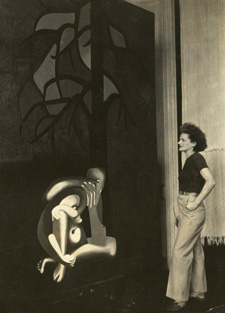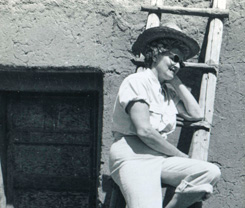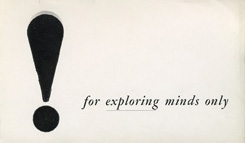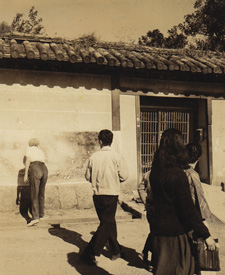1940-1959
click on thumbnail images to see full size photos
1940 – Rents a studio at 18 West 16th Street.
1941 – Leaves the Ozenfant School of Fine Arts. Begins teaching in her own studio and at the Parsons School of Design. Hosts an exhibition of Negro Sculpture from East and West Africa at her studio. Befriends the English Surrealist artist Gordon Onslow Ford and abstract painters Mark Rothko and Theodoros Stamos.
1942 – First solo exhibition Sari Dienes – Twenty Drawings at the New School for Social Research, New York. Ozenfant, upon reviewing this exhibition, related, “She now has the courage to disregard everything she knows in order to discover what she knows nothing about.”
1944 – Solo exhibition at Parsons School of Design, New York.
1945 – Moves to Sherwood Studios at 58 West 57th Street, also home to artists Addie Herder and Anne Winter. Around this time befriends composer John Cage and choreographer Merce Cunningham.
1946 – Meets artist Ray Johnson, who remains a lifelong friend. Teaches a course in drawing and composition for the Brooklyn Museum Art School at her own studio until 1949.
1947 – Three-month trip to Arizona, Colorado, New Mexico and Utah has a profound effect on her approach to art and life. Sari stays with former student and friend Stella Snead while visiting Taos.
1948 – Exhibits abstract oil paintings, watercolors, and assemblages of found objects including driftwood and shells at the Carlebach Gallery, New York.
1949 – Makes etchings and engravings at Stanley William Hayter’s Atelier 17 at the New School for Social Research. Shows her prints in a solo exhibition at the Wittenborn Gallery, New York. Participates in the Fourteenth Exhibition of Prints by Members of the Atelier 17 Group at the Laurel Gallery, New York and the Third National Print Annual Exhibition at the Brooklyn Museum.
1950 – Makes a series of ‘Plaster Collages.’ First of four solo exhibitions at Betty Parsons Gallery, New York. Magic, Group Show at Perspectives Gallery
1951 – First of three residencies at the MacDowell Colony in Peterborough, New Hampshire. Travels to Columbus, Ohio in the summer. Exhibits at the Salon des réalités nouvelles in Paris.
1952 – Designs sets and costumes for Arthur Gregor’s play Fire at the Lincoln Hall Theatre, University of Illinois at Urbana. Travels to Bozeman, Montana, for a solo exhibition at Montana State University. Begins to experiment with ceramics. Befriends dancer Mura Dehn, and will later serve on Mura’s Traditional Jazz Dance Company board.
1953 – Residency at MacDowell Colony in Peterborough, New Hampshire. During a spring residency at Yaddo artists’ retreat in Saratoga Springs, makes rubbings of natural materials and household objects, using a printer’s brayer and colored inks. Back in New York in the summer, applies this technique to the urban environment, taking rubbings from the streets, manhole covers and subway gratings to create an innovative series of large-scale ‘Sidewalk Rubbings,’ sometimes assisted by John Cage, Jasper Johns, or Rachel Rosenthal.
1954 – Gains American citizenship. Residencies at the Research Studio, Maitland, Florida and at the MacDowell Colony in Peterborough, New Hampshire. Second solo exhibition at Betty Parsons Gallery, New York, includes her ‘Sidewalk Rubbings’ and works made, ‘using not only brushes but rollers, rags and even fingers, in a method similar to the one used in making ordinary rubbings. The variation and construction depending on the selection of objects directly contacted and the decided action. Some of the paintings are done on paper because of its readiness to respond to more subtle detail. In every case the emphasis is on the creating of the visual object and not on the procedure’. Makes rubbings of gravestones during residency at the Cummington School of the Arts in Cummington, Massachusetts. Designs textiles for L. Anton Maix Fabrics, New York. The November 15th issue of Life magazine features an article on her rubbings technique.
mid-1950s – Attends D.T. Suzuki’s weekly afternoon lectures on Zen Buddhism at Columbia University with Earle Brown, John Cage, Morton Feldman, Ray Johnson, Jackson Mac Low, Isamu Noguchi, and Betty Parsons, often followed by a soirée at her 57th Street studio. Jasper Johns befriends John Cage and Robert Rauschenberg at one such studio gathering in 1954.
1955 – Spring residency at the Huntingdon Hartford Foundation, Pacific Palisades, California. While in California, a fire in her 57th Street Studio destroys some of her works and those of Robert Rauschenberg stored there. ‘Sidewalk Rubbings’ and ‘Plaster Collages’ displayed in the windows of Bonwit Teller department store in New York. Third solo exhibition at Betty Parsons Gallery, New York, featuring “66” also known as “From Seed to Sky”, a 66’ long rubbing displayed as a labyrinth.
1956 – The March-April issue of Craft Horizons features an article by M.C. Richards on ‘Sari Dienes: Unconventional Use of Print Techniques.’ Signs contract for textiles La Mer and Atlantis with Associated American Artists Galleries. Her textile design Tree Saw selected for inclusion in a yearlong traveling exhibition of the American Institute of Decorators and her textiles Circles and Tree Saw for Jack Lenor Larsen are included in the exhibition Design by the Yard: Textile Printing from 800 to 1956 at the Cooper Union in New York. Begins a series of ‘Bottle Gardens,’ assemblages of glass bottles, some of them housed in glass fish tanks. She also makes assemblages from driftwood, plaster, metal and found objects. Commissioned by the University of Washington, on an expedition led by Mark Hedden, makes rubbings of several hundred Native American petroglyphs soon to be submerged due to the construction of the Dalles Dam. Travels to San Francisco, where she has an exhibition of her petroglyph rubbings at the Palace of the Legion of Honor. Studies Japanese in preparation for moving to Japan. Visits Gordon Onslow Ford in San Francisco and Rachel Rosenthal in Los Angeles.
1957 – Remains in San Francisco for her solo exhibition at Gump’s Gallery. In April makes rubbings of petroglyphs in Hawaii en route to Japan. Studies calligraphy, traditional woodblock printing, and ceramics with master potter Teruo Hara, who wins the Grand Prize at Expo 58 in Brussels. Under his tutelage, begins to experiment with collages constructed from different colored clays. In Kyoto makes rubbings of incised wall graffiti. Befriends artists Nankoku Hidai, Isamu Kenmochi, and Rikio Takahashi.
1958 – Solo exhibitions at the Yamada Art Gallery in Kyoto and the Toyoko Gallery in Tokyo. In December sails from Yokohama to San Pedro, California, upon news of eviction from her home, The Sherwood Studios 58 West 57th NYC, that was to be demolished. Visits Rachel Rosenthal in Los Angeles.
1959 – The March issue of Industrial Design magazine features article on ‘Sidewalk Rubbings.’ Contributes ‘Notes on Japan, Notes on Art’ to journal It Is. Gives a salvaged stuffed bald eagle to Robert Rauschenberg, who incorporates it in his combine Canyon, now in the Museum of Modern Art, New York. Included in the American Federation of Arts touring exhibition Art and the Found Object together with Joseph Cornell, Marcel Duchamp, Max Ernst, Man Ray, Louise Nevelson, Robert Rauschenberg, and Kurt Schwitters, and exhibits her clay collages and ‘Walls of Kyoto’ rubbings in her final solo exhibition at the Betty Parsons Gallery.
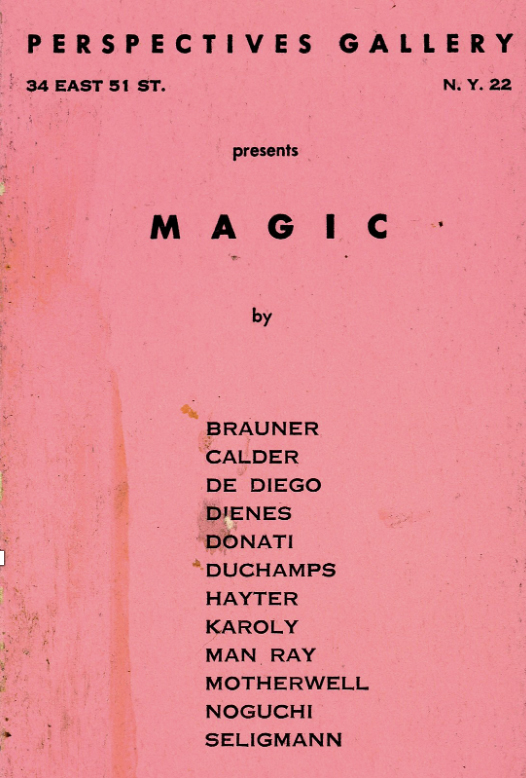
1950, Magic, Group Show at Perspectives Gallery
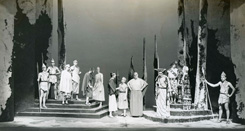
Sets and costumes for Arthur Gregor’s play Fire, Urbana, 1952
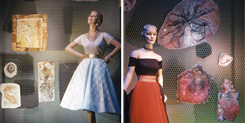
Plaster collages in Bonwit Teller windows, New York, 1956 – photos Virginia Roehl
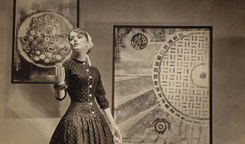
Sidewalk Rubbings in Bonwit Teller windows, New York, 1955 – photos Virginia Roehl
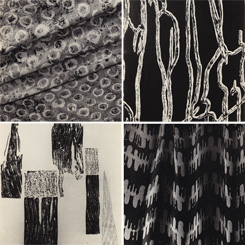
Textile designs, clockwise: Circles, Tanglewood, Tree Saw and Timber, 1955
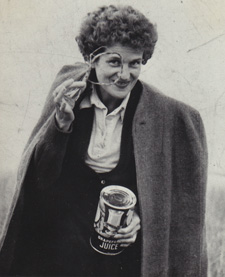
Collecting scrap materials, 1940s – photographer unknown
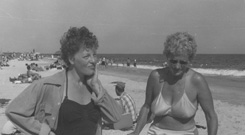
With Rachel Rosenthal, Jones Beach, c.1955





Making rubbings of petroglyphs along the Columbia River, Washington/Oregon, 1956 – photos Mark Hedden

